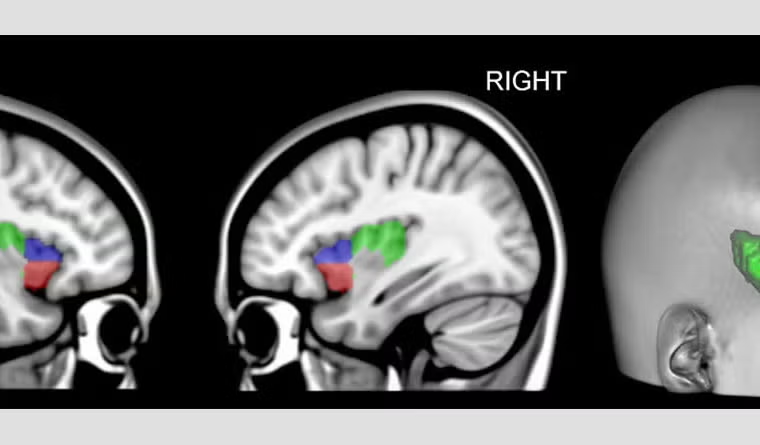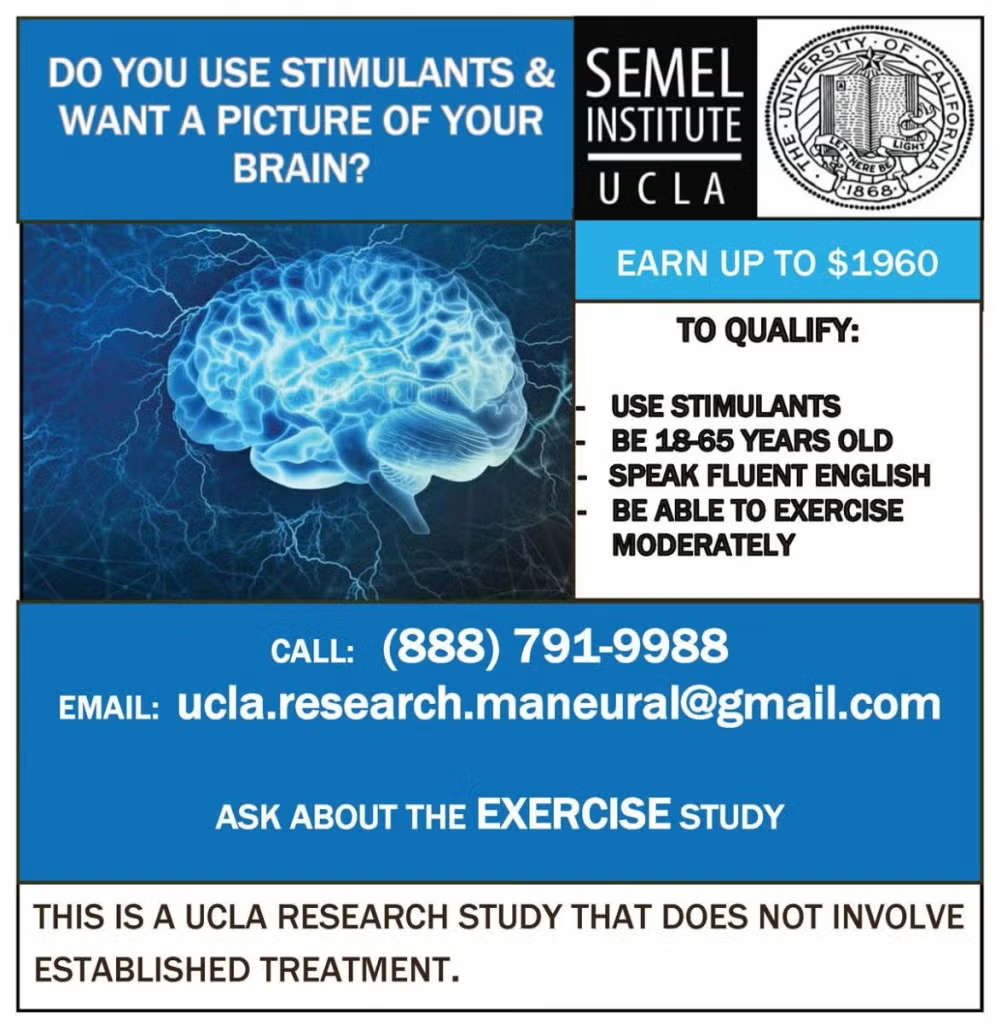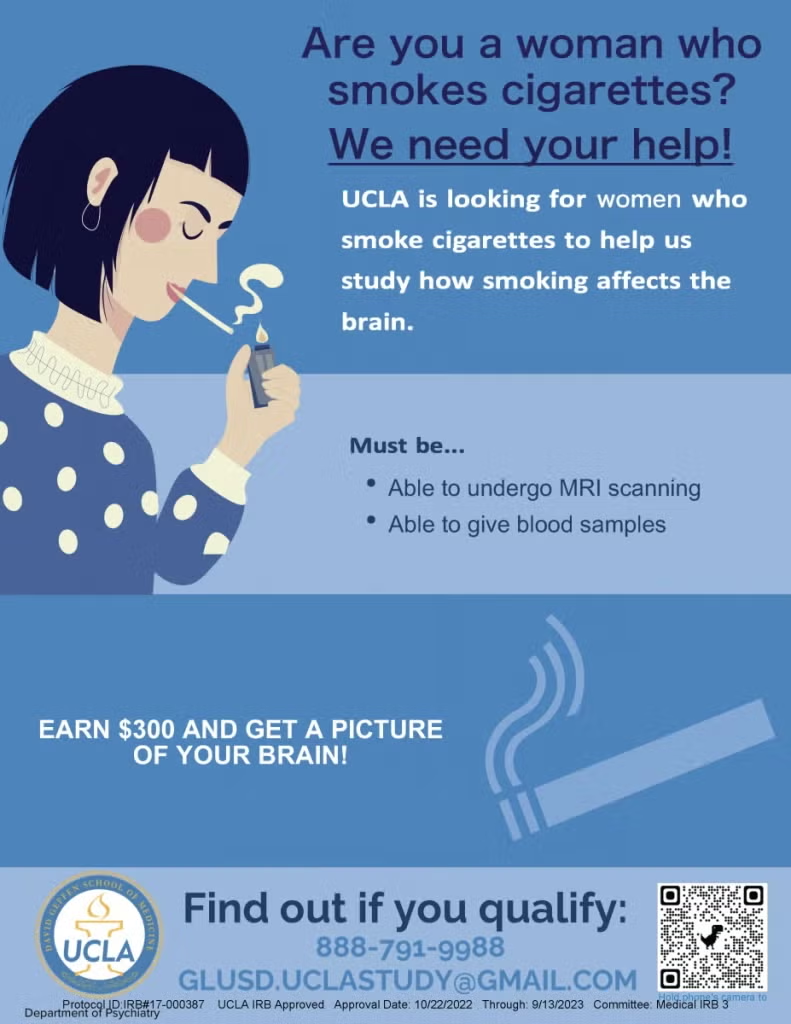Research Laboratory

Leadership
Edythe London, PhD
Director
Contact Info
760 Westwood Plaza
Los Angeles, CA
(888) 791-9988 (for research study recruitment only)
About
The Neuroimaging and Addiction Treatment Laboratory (NATL) conducts research on the neural correlates of substance use disorders and potential treatments. We use multi-modal imaging techniques, including structural and functional magnetic resonance imaging (MRI) and position emission tomography (PET), to investigate the neural circuitry underlying impulsivity, self-control and other neurocognitive functions and behaviors related to addiction. Our research aims to help clarify the links between genetic variation, brain chemistry and activity in neural circuits related to decision-making and other cognitive functions that maintain addiction. Ongoing studies also involve novel approaches and medications to enhance brain function and self-control during recovery.
Research
Neural Systems, Inhibitory Control, and Methamphetamine Dependence
We are conducting research on brain structure and function in individuals with Methamphetamine Use Disorder. Chronic use of methamphetamine impairs cognitive brain function, and we are investigating how cognitive deficits in methamphetamine are related to the structure of people who misuse. We are also using functional MRI to assess how brain activity differs between these people and healthy, control participants. We are investigating how potential treatments may help improve the cognition and brain function of individuals with Methamphetamine Use Disorder. This includes the use of an exercise training regimen and medications.
Dopamine Receptor Upregulation in Stimulant Use Disorder
Stimulant Use Disorder is characterized a deficit in D2-type dopamine receptors in the striatum. In healthy people, these receptors are liked to self-control and adaptive decision-making, and substantial evidence suggests that improving signaling through them can improve those cognitive functions. We have shown that exercise training as an adjunct to behavioral therapy upregulated D2-type dopamine receptors in people with Methamphetamine Use Disorder to the levels in healthy controls. This project uses multi-modal brain imaging to evaluate whether receptor upregulation in this population is associated with improved brain function. In addition, potential pharmacological upregulation of D2-type receptors with varenicline is being evaluated using brain imaging (PET and fMRI scanning) and behavioral assay.
Sex Differences in the Neural Correlates of Cigarette Smoking
The use of combustible tobacco products, primarily cigarettes, is responsible for more than half a million preventable deaths per year in the US. Most people who smoke want to quit, and available treatments help some of them. Although there are medications to facilitate smoking cessation, quit rates are low and there are sex differences in the untoward effects of smoking and in the response to smoking-cessation medications. This project uses multi-modal brain imaging (structural and functional fMRI, magnetic resonance spectroscopy) and behavioral assay to identify sex differences in the neural correlates of craving, withdrawal and responses to smoking. The goal is to develop personalized treatments that consider the role of sex in facilitating smoking cessation.
Cannabidiol as Adjunctive Treatment for Opioid Use Disorder
With over 100,000 overdose deaths in the US during 2021, the need for novel treatments cannot be overstated. There are FDA-approved medications for Opioid Use Disorder, the most efficacious being the opioid replacement therapies, buprenorphine. And methadone. Yet within months of initiating treatment, about half of the patients relapse. One problem that is cited is craving for opioids, and this craving is thought to drive relapse. Following reports that cannabidiol, a non-psychoactive cannabis derivative, reduces opioid craving, this project is evaluating the safety and initial efficacy of cannabidiol as adjunctive therapy for patients receiving opioid replacement therapy with buprenorphine.
Glutamate receptors and Stimulant Use Disorder
While the mGlu5 glutamate receptor is linked to a number of important brain disorders and to the propensity of animals to self-administer methamphetamine, this receptor has not been evaluated in people with Methamphetamine Use Disorder. This project examines regional brain mGlu5 levels in individuals with Methamphetamine Use Disorder and examines relationships with impairments in decision making, cognitive function, and psychiatric symptoms.
Participate in a Study
Stimulant Studies
STIMULANT USERS (Methamphetamine/Cocaine)
Are you a healthy individual between the ages of 18-65? We are currently recruiting subjects for a stimulant (such as methamphetamine or cocaine) research study. If you qualify, you could receive up to $1960 and a picture of your brain. Call toll free: 888-791-9988 & ask for the EXERCISE study, or email: ucla.research.maneural@gmail.com for more information.
HEALTHY CONTROLS
Are you a healthy individual between the ages of 18-45? We are currently recruiting controls for a methamphetamine research study. If you qualify, you could receive up to $265 and a picture of your brain. Call toll free: 888-791-9988 & ask for the METH study, or email: ucla.research.maneural@gmail.com for more information.
CIGARETTE SMOKERS
Are you a cigarette smoker between the ages of 18-45? We are currently recruiting controls for a methamphetamine research study. If you qualify, you could receive up to $265 and a picture of your brain. Call toll free: 888-791-9988 & ask for the METH study, or email: ucla.research.maneural@gmail.com for more information.

Smoking Study
Do you smoke cigarettes? Our laboratory is looking for people who smoke cigarettes to help us understand how smoking affects the brain. If you qualify, you could receive up to $300 and a picture of your brain.
Call toll free: 888-791-9988 AND ******ASK FOR THE GLUSD STUDY********
Or email: GluSD.uclastudy@gmail.com. Please include your PHONE NUMBER when emailing.

Team
-

Edythe London, Ph.D.
Program Director -

Andrew C. Dean, Ph.D.
Faculty -

Rich De La Garza, Ph.D.
Faculty -

Dara Ghahremani, Ph.D.
Faculty -

Jean-Baptiste Pochon, Ph.D.
Faculty -

Daicia Allen, Ph.D.
Postdoctoral Fellow -

Megan McClintick, Ph.D.
Postdoctoral Fellow -

Olivia Jarrett
Research Associate -

Shane Marohnic
Research Associate -

Luke Osborn
Research Associate -

Jalen Grayson
Graduate Student -

Julia Talavera
Research Associate -

Justine Chen
Research Associate -

Andrew Otterson
Research Associate
Laboratory Alumni
-

Nicole Petersen, Ph.D.
Former Faculty -

Zoe Guttman
Former Graduate Student -

Tarannom Mahmoudie, M.D.
Former Postoctoral Fellow -

Johannes Petzold, M.D., Ph.D.
Former Visiting Scholar -

Maylen Perez Diaz, Ph.D.
Former Postdoctoral Fellow
Faculty
Johannes Petzold, M.D., Ph.D.
Physician Researcher, Universitätsklinikum Carl Gustav Carus Dresden
Nicole Petersen, Ph.D.
Assistant Professor, Department of Psychiatry & Biobehavioral Sciences at UCLA
https://www.translational-neuroimaging.com/people
Steve Berman, Ph.D.
Research Professor, UCLA, Retired
http://people.healthsciences.ucla.edu/institution/personnel?personnel_id=45325
John Monterosso, Ph.D.
Associate Professor of Psychology, University of Southern California
https://dornsife.usc.edu/cf/faculty-and-staff/faculty.cfm?pid=1022683
Amira Brown, Ph.D.
Assistant Professor, Charles R. Drew University of Medicine and Science
http://profiles.cdrewu.edu/profiles/ProfileDetails.aspx?From=SE&Person=11
Rajkumar Sevak, Ph.D., R.Ph
Assistant Professor, Thomas J. Long School of Pharmacy at University of the Pacific
https://pharmacy.pacific.edu/campus-directory/raj-sevak
Todd Zorick, M.D., Ph.D.
Associate Clinical Professor of Psychiatry, UCLA
Staff Psychiatrist, Harbor-UCLA Medical Center
Investigator, The Lundquist Institute
https://lundquist.org/todd-zorick-md-phd
Jiansong Xu, M.D., Ph.D.
Former Assistant Professor of Psychiatry, Yale University School of Medicine
Andrei Koren, Ph.D.
Senior Scientist and Lab Head, Banner Health
Trainees
Tarannom Mahmoudie, M.D.
Family Medicine Resident Phsyician, Eisenhower Health
Maylen Perez-Diaz, Ph.D.
Medical Science Liason, Biogen
Zoe Guttman, Ph.D.
Research and Strategic Growth Specialist, California Council of Community Behavioral Health Agencies
Paul Faulkner, Ph.D.
Senior Lecturer, University of Roehampton
https://pure.roehampton.ac.uk/portal/en/persons/paul-faulkner
Milky Kohno, Ph.D.
Assistant Professor, Oregon Health & Sciences University
https://www.ohsu.edu/people/milky-kohno-phd
Angelica Morales,Ph.D.
Assistant Professor of Psychiatry, Oregon Health & Sciences University
https://www.ohsu.edu/people/angelica-morales-phd
Kyoji Okita, M.D. Ph.D.
Physician Researcher, National Center of Neurology and Psychiatry
https://www.researchgate.net/profile/Kyoji_Okita2
Adrianna Mendrek, Ph.D.
Researcher, Institut universitaire en santé mentale de Montréal Research Center
Associate Professor, Bishop University Department of Psychology
http://www.iusmm.ca/research/researchers/researchers/adrianna-mendrek.html
Aaron Lichtman, M.D.
Nuclear Medicine Physician
http://health.usnews.com/doctors/aaron-lichtman-752520
https://www.doximity.com/pub/aaron-lichtman-md
Golnaz Tabibnia, Ph.D.
Assistant Research Faculty, University of California, Irvine
https://faculty.sites.uci.edu/gtabibnia/
Michael Ballard, Ph.D.
Clinical Scientist, Neumora
https://www.researchgate.net/profile/Michael-Ballard-4
Catherine Canamar, Ph.D.
Kate Baicy, M.D., Ph.D.
General Obstetrics & Gynecologic Physician, NYU Langone Health
http://nyulangone.org/doctors/1285952093/kate-j-baicy
Doris Payer, Ph.D.
Addiction Neuroscientist, Can Centre on Substance Use and Addiction
https://www.ccsa.ca/doris-payer-phd
Johanna Jarcho, Ph.D.
Assistant Professor of Psychology, Temple University
https://liberalarts.temple.edu/academics/faculty/jarcho-johanna
Stephanie Groman, Ph.D.
Assistant Professor of Neuroscience, University of Minnesota School of Medicine
https://med.umn.edu/bio/medical-discovery-teams/stephanie-groman
Christopher Steven Culbertson, Ph.D.
Senior Vice President of Marketing & Data Strategy, Live Nation Entertainment
https://www.linkedin.com/in/christopher-culbertson-ph-d-122a72b/
Chelsea Robertson, Ph.D.
Product Scientist II, 23 and Me
https://www.linkedin.com/in/chelsea-lyn-robertson-phd/
Training
Post-Doctoral Positions in Neuroimaging of Addiction
The UCLA Laboratory of Molecular Neuroimaging has postdoctoral positions available for involvement in NIH- and foundation-funded multimodality magnetic resonance imaging (structural MRI, fMRI, MRS) and PET research projects in substance use disorders. Research includes studies of recruited healthy control participants and patient populations (Tobacco, Stimulant and Opioid Use Disorders) and large datasets to evaluate neural bases of behavioral deficits and effects of interventions, including behavioral, brain-stimulation and pharmacological treatments. This work is performed in the context of UCLA’s state-of-the-art neuroimaging centers – Center for Cognitive Neuroscience and Brain Mapping Center – with exciting opportunities for bidirectional research translation with basic science laboratories and clinical research programs across the university. All candidates must have relevant neuroimaging research experience (see below) with related references. Postdoctoral candidates must have an PhD or MD in a relevant research field.
Interested applicants should have hands-on experience in brain imaging data acquisition and technical experience with analysis of neuroimaging data (e.g., fMRI, structural MRI, MRS, PET). Experience in both univariate and multivariate statistical approaches is preferred and in diverse neuroimaging software environments (e.g., FSL, SPM, Freesurfer, nilearn, NiPype). Proficiency in programming (i.e., Matlab, Python, Unix/Linux shell, and/or other languages).
Salary will be commensurate with training level. UCLA is an equal-opportunity employer. Women and minorities are strongly encouraged to apply.
Applications are currently being accepted for employment to start as soon as possible.
APPLICATION PROCEDURE:
Applications must include the following items in order to be considered:
- Current curriculum vitae
- Letter of intent
- Names and contact info for three references
Interested applicants should email Dr. Edythe London (elondon@mednet.ucla.edu)
(see also T32 UCLA Training Program in Translational Neuroscience of Drug Addiction)
UCLA’s T32 Translational Neuroscience on Drug Abuse Training Program
OVERVIEW
Now in its 14th year, the UCLA Training Program on the Translational Neuroscience of Drug Abuse (TNDA) supports pre- and postdoctoral trainees aspiring to become leaders in the field. TNDA graduates have successful careers in academic research, industry, science policy, teaching and scientific writing.
Each year, 5 predoctoral and 2 postdoctoral trainees are competitively selected to receive 12-month fellowships with the possibility of renewal (start or after July 1, 2022).
The TNDA Program comprises core activities, which include developing and conducting mentored research projects, training in oral and written presentations, completing selected coursework and training in the responsible conduct of research.
Program Director: Edythe London, Ph.D.
TNDA Faculty. Mentors work in various disciplines, but their work often spans more than one focus area.
| Molecular & Cellular Neuroscience | Integrative Neuroscience | Cognitive Neuroscience |
| Anne Andrews | Ziva Cooper | Edythe London |
| Catherine M. Cahill | Michael Fanselow | Erika Nurmi |
| Christopher Evans | Alicia Izquierdo | Adriana Galvan |
| David Krantz | Barbara Knowlton | Pamela Kennedy |
| Igor Spigelman | Nigel Maidment | Lara Ray |
| Melissa Sharpe | ||
| Kate Wassum | ||
| Andrew Wikenheiser |
PREDOCTORAL APPLICATION
Qualified Applicants Must:
- Be pursuing a Ph.D. in neuroscience, biological science, psychology, pharmacology, or related field under the supervision of a TNDA mentor at UCLA (see faculty list above)
- Be committed to the study of drug addiction;
- Have US citizenship or non-citizen nationality (born in US outlying possessions) or permanent residency;
- Have received no more than 5 years of predoctoral NRSA support (individual & institutional awards combined).
Application Process. Submit the completed application package via email to the TNDA Program Administrator, Mario Mandujano (mmandujano@mednet.ucla.edu). Paper applications will NOT be accepted. The application package should include the following:
1) Information Sheet. Download, complete and sign this form: Information Sheet.
2) Self-Statement (maximum of 3 pages, single spaced, 11-point Arial font, 0.5-inch margins). Provide a general description of a proposed research project including aims, data point collection and potential outcomes. The statement should also highlight your research/education accomplishments and background relevant to your interest in drug abuse research. You must name the UCLA TNDA Faculty member who has agreed to serve as your mentor for the duration of the fellowship. A reference list does not count toward the 3-page limit.
*Trainees who are-applying for renewal should submit a progress report indicating a plan for the next year.
3) Curriculum vitae including list of publications.
4) Nomination letter written by a faculty member or mentor who knows you well.
APPLICATION DEADLINE: May 15, 2022, 5:00 PM Pacific Time.
Award notifications are sent out by May 1 of the appointment year.
POSTDOCTORAL APPLICATION
Qualified Applicants Must:
- Have a doctoral degree, (M.D. or Ph.D. in neuroscience, biological science, psychology, pharmacology or related field) by the time of appointment. Degree confirmation is required at the time of official appointment;
- Be committed to the study of drug addiction;
- Have US citizenship or non-citizen nationality (born in US outlying possessions) or permanent residency;
- Have received no more than 3 years of postdoctoral NRSA support (individual & institutional awards combined).
Application Process.
STEP 1: PRE-APPLICATION REVIEW
Interested individuals must submit a current CV for consideration. Submit via email to the program administrator, Julia Birenbaum (jbirenbaum@mednet.ucla.edu). You may also contact Ms. Joan Madden-Ceballos with program-related questions.
STEP 2: FORMAL APPLICATION
Upon approval, complete the following steps:
- Mentor Selection: From the TNDA Faculty (above), select a mentor and initiate discussion of a research proposal and the mentor’s approval to conduct the proposed work in their laboratory.
- Submit Application Package: Applicants must submit all elements of the application package electronically by the deadline.
Application Package:
1) Information Sheet: Download, complete and sign this form: Information Sheet.
2) Self-Statement (max 3 pages, single spaced, 11-point Arial font, .5-inch margins): Provide a general description of your proposed research project including aims, data point collection and potential outcomes. The statement should also highlight your research/education accomplishments and provide background information relevant to your interest in drug abuse research. Applicants must name the TNDA faculty member mentor who has agreed to serve as their mentor. A bibliography does not count toward the 3-page limit.
*Current fellows applying for renewal should submit a progress report on their research and achievements in the past year, and future directions for a second year of research.
3) Nomination letter: Provide a formal letter of recommendation written by a faculty member or mentor who knows you best
Submission & Notification of Award
Submission: Submit completed application packages via email to the TNDA Program Administrator, Julia Birenbaum (jbirenbaum@mednet.ucla.edu). Paper applications will NOT be accepted.
Publications
2022
Wolitzky-Taylor, K., Glasner, S., Tanner, A., Ghahremani, D. G., & London, E. D. (2022). Targeting maladaptive reactivity to negative affect in emerging adults with cannabis use disorder: A preliminary test and proof of concept. Behaviour research and therapy, 104032.
Ekhtiari, H., Zare-Bidoky, M., Sangchooli, A., Janes, A. C., Kaufman, M. J., Oliver, J. A., … & Zilverstand, A. (2022). A methodological checklist for fMRI drug cue reactivity studies: development and expert consensus. Nature Protocols, 1-31.
Ottino-González, J., Uhlmann, A., Hahn, S., Cao, Z., Cupertino, R. B., Schwab, N., … & Garavan, H. (2022). White matter microstructure differences in individuals with dependence on cocaine, methamphetamine, and nicotine: Findings from the ENIGMA-Addiction working group. Drug and alcohol dependence, 230, 109185.
Hahn, S., Mackey, S., Cousijn, J., Foxe, J. J., Heinz, A., Hester, R., … & Garavan, H. (2022). Predicting alcohol dependence from multi‐site brain structural measures. Human Brain Mapping, 43(1), 555-565.
Kong, X. Z., ENIGMA Laterality Working Group, Francks, C., Kong, X. Z., Mathias, S. R., Guadalupe, T., … & Maingault, S. (2022). Reproducibility in the absence of selective reporting: An illustration from large‐scale brain asymmetry research. Human brain mapping, 43(1), 244-254.
2021
van Nunen LJ, Lake MT, Ipser JC, Stein DJ, Shoptaw SJ, London ED. Executive Function and Contingency Management in Methamphetamine Use Disorder. Journal of alcoholism and drug dependence. 2021;9(5).
Petzold J, Szumlinski KK, London ED. Targeting mGlu(5) for Methamphetamine Use Disorder. Pharmacology & therapeutics. 2021;224:107831.
Petersen N, Rapkin AJ, Okita K, Kinney KR, Mizuno T, Mandelkern MA, et al. Striatal dopamine D(2)-type receptor availability and peripheral 17β-estradiol. Molecular psychiatry. 2021.
Petersen N, Kearley NW, Ghahremani DG, Pochon JB, Fry ME, Rapkin AJ, et al. Effects of oral contraceptive pills on mood and magnetic resonance imaging measures of prefrontal cortical thickness. Molecular psychiatry. 2021;26(3):917-26.
Perez Diaz M, Pochon JB, Ghahremani DG, Dean AC, Faulkner P, Petersen N, et al. Sex Differences in the Association of Cigarette Craving with Insula Structure. The international journal of neuropsychopharmacology. 2021;24(8):624-33.
Nie L, Ghahremani DG, Mandelkern MA, Dean AC, Luo W, Ren A, et al. The relationship between duration of abstinence and gray-matter brain structure in chronic methamphetamine users. The American journal of drug and alcohol abuse. 2021;47(1):65-73.
Guttman ZR, Ghahremani DG, Pochon JB, Dean AC, London ED. Age Influences Loss Aversion Through Effects on Posterior Cingulate Cortical Thickness. Frontiers in neuroscience. 2021;15:673106.
Ghahremani DG, Pochon JB, Perez Diaz M, Tyndale RF, Dean AC, London ED. Functional connectivity of the anterior insula during withdrawal from cigarette smoking. Neuropsychopharmacology : official publication of the American College of Neuropsychopharmacology. 2021.
Dean AC, Nurmi EL, Morales AM, Cho AK, Seaman LC, London ED. CYP2D6 genotype may moderate measures of brain structure in methamphetamine users. Addiction biology. 2021;26(3):e12950.
Cao Z, Ottino-Gonzalez J, Cupertino RB, Schwab N, Hoke C, Catherine O, et al. Mapping cortical and subcortical asymmetries in substance dependence: Findings from the ENIGMA Addiction Working Group. Addiction biology. 2021;26(5):e13010.
Burnette EM, Grodin EN, Ghahremani DG, Galván A, Kohno M, Ray LA, et al. Diminished cortical response to risk and loss during risky decision making in alcohol use disorder. Drug and alcohol dependence. 2021;218:108391..
2020
Yang M, Yang C, Liu T, London ED. Methamphetamine-associated psychosis: links to drug use characteristics and similarity to primary psychosis. International journal of psychiatry in clinical practice. 2020;24(1):31-7.
Thorberg FA, Hasking P, Huang YL, Lyvers M, Young RM, Connor JP, et al. The Influence of Alexithymia on Alcohol Craving, Health-Related Quality of Life and Gender in Alcohol-Dependent Outpatients. Journal of psychoactive drugs. 2020;52(4):366-76.
Okafor CN, Stein DJ, Dannatt L, Ipser J, van Nunen LJ, Lake MT, et al. Contingency management treatment for methamphetamine use disorder in South Africa. Drug and alcohol review. 2020;39(3):216-22.
Moeller SJ, Kundu P, Bachi K, Maloney T, Malaker P, Parvaz MA, et al. Self-awareness of problematic drug use: Preliminary validation of a new fMRI task to assess underlying neurocircuitry. Drug and alcohol dependence. 2020;209:107930.
London ED, Okita K, Kinney KR, Dean AC, McClintick MN, Rizor EJ, et al. No significant elevation of translocator protein binding in the brains of recently abstinent methamphetamine users. Drug and alcohol dependence. 2020;213:108104.
London ED. Human Brain Imaging Links Dopaminergic Systems to Impulsivity. Current topics in behavioral neurosciences. 2020;47:53-71.
Lim AC, Grodin EN, Green R, Venegas A, Meredith LR, Courtney KE, et al. Executive function moderates naltrexone effects on methamphetamine-induced craving and subjective responses. The American journal of drug and alcohol abuse. 2020;46(5):565-76.
Lake MT, Shoptaw S, Ipser JC, Takada S, van Nunen LJ, Lipinska G, et al. Decision-Making by Patients With Methamphetamine Use Disorder Receiving Contingency Management Treatment: Magnitude and Frequency Effects. Frontiers in psychiatry. 2020;11:22.
Kong XZ, Francks C. Reproducibility in the absence of selective reporting: An illustration from large-scale brain asymmetry research. Human brain mapping. 2020.
Faulkner P, Dean AC, Ghahremani DG, London ED. Neural Basis of Smoking-Related Difficulties in Emotion Regulation. The international journal of neuropsychopharmacology. 2020;23(7):409-16.
Chye Y, Mackey S, Gutman BA, Ching CRK, Batalla A, Blaine S, et al. Subcortical surface morphometry in substance dependence: An ENIGMA addiction working group study. Addiction biology. 2020;25(6):e12830.
Bari AA, Sparks H, Levinson S, Wilson B, London ED, Langevin JP, et al. Amygdala Structural Connectivity Is Associated With Impulsive Choice and Difficulty Quitting Smoking. Frontiers in behavioral neuroscience. 2020;14:117.
2019
Zorick T, Okita K, Mandelkern MA, London ED, Brody AL. Effects of Citalopram on Cue-Induced Alcohol Craving and Thalamic D2/3 Dopamine Receptor Availability. The international journal of neuropsychopharmacology. 2019;22(4):286-91.
Thorberg FA, Young RM, Hasking P, Lyvers M, Connor JP, London ED, et al. Alexithymia and Alcohol Dependence: The Roles of Negative Mood and Alcohol Craving. Substance use & misuse. 2019;54(14):2380-6.
Tang J, O’Neill J, Alger JR, Shen Z, Johnson MC, London ED. N-Acetyl and Glutamatergic Neurometabolites in Perisylvian Brain Regions of Methamphetamine Users. The international journal of neuropsychopharmacology. 2019;22(1):1-9.
Petzold J, Lee Y, Pooseh S, Oehme L, Beuthien-Baumann B, London ED, et al. Presynaptic dopamine function measured with [(18)F]fluorodopa and L-DOPA effects on impulsive choice. Scientific reports. 2019;9(1):17927.
Petzold J, Kienast A, Lee Y, Pooseh S, London ED, Goschke T, et al. Baseline impulsivity may moderate L-DOPA effects on value-based decision-making. Scientific reports. 2019;9(1):5652.
Petersen N, Ghahremani DG, Rapkin AJ, Berman SM, Wijker N, Liang L, et al. Resting-state functional connectivity in women with PMDD. Translational psychiatry. 2019;9(1):339.
Liu Y, van den Wildenberg WPM, de Graaf Y, Ames SL, Baldacchino A, Bø R, et al. Is (poly-) substance use associated with impaired inhibitory control? A mega-analysis controlling for confounders. Neuroscience and biobehavioral reviews. 2019;105:288-304.
Faulkner P, Ghahremani DG, Tyndale RF, Paterson NE, Cox C, Ginder N, et al. Neural basis of smoking-induced relief of craving and negative affect: Contribution of nicotine. Addiction biology. 2019;24(5):1087-95.
Dean AC, Nurmi EL, Moeller SJ, Amir N, Rozenman M, Ghahremani DG, et al. No effect of attentional bias modification training in methamphetamine users receiving residential treatment. Psychopharmacology. 2019;236(2):709-21.
Burggren AC, Shirazi A, Ginder N, London ED. Cannabis effects on brain structure, function, and cognition: considerations for medical uses of cannabis and its derivatives. The American journal of drug and alcohol abuse. 2019;45(6):563-79.
2018
Zheutlin AB, Chekroud AM, Polimanti R, Gelernter J, Sabb FW, Bilder RM, et al. Multivariate Pattern Analysis of Genotype-Phenotype Relationships in Schizophrenia. Schizophrenia bulletin. 2018;44(5):1045-52.
Verdejo-Garcia A, Chong TT, Stout JC, Yücel M, London ED. Stages of dysfunctional decision-making in addiction. Pharmacology, biochemistry, and behavior. 2018;164:99-105.
Petersen N, London ED. Addiction and Dopamine: Sex Differences and Insights from Studies of Smoking. Current opinion in behavioral sciences. 2018;23:150-9.
Petersen N, Ghahremani DG, Rapkin AJ, Berman SM, Liang L, London ED. Brain activation during emotion regulation in women with premenstrual dysphoric disorder. Psychological medicine. 2018;48(11):1795-802.
Okita K, Morales AM, Dean AC, Johnson MC, Lu V, Farahi J, et al. Striatal dopamine D1-type receptor availability: no difference from control but association with cortical thickness in methamphetamine users. Molecular psychiatry. 2018;23(5):1320-7.
Nie L, Zhaom Z, Wen X, Luo W, Ju T, Ren A, et al. Factors affecting the occurrence of psychotic symptoms in chronic methamphetamine users. Journal of addictive diseases. 2018;37(3-4):202-10.
Moeller SJ, Okita K, Robertson CL, Ballard ME, Konova AB, Goldstein RZ, et al. Low Striatal Dopamine D2-type Receptor Availability is Linked to Simulated Drug Choice in Methamphetamine Users. Neuropsychopharmacology : official publication of the American College of Neuropsychopharmacology. 2018;43(4):751-60.
Kong XZ, Mathias SR, Guadalupe T, Glahn DC, Franke B, Crivello F, et al. Mapping cortical brain asymmetry in 17,141 healthy individuals worldwide via the ENIGMA Consortium. Proceedings of the National Academy of Sciences of the United States of America. 2018;115(22):E5154-e63.
Guttman Z, Moeller SJ, London ED. Neural underpinnings of maladaptive decision-making in addictions. Pharmacology, biochemistry, and behavior. 2018;164:84-98.
Ghahremani DG, Faulkner P, C MC, London ED. Behavioral and neural markers of cigarette-craving regulation in young-adult smokers during abstinence and after smoking. Neuropsychopharmacology : official publication of the American College of Neuropsychopharmacology. 2018;43(7):1616-22.
Faulkner P, Petersen N, Ghahremani DG, Cox CM, Tyndale RF, Hellemann GS, et al. Sex differences in tobacco withdrawal and responses to smoking reduced-nicotine cigarettes in young smokers. Psychopharmacology. 2018;235(1):193-202.
Faulkner P, Ghahremani DG, Tyndale RF, Hellemann G, London ED. Functional Connectivity of the Raphe Nuclei: Link to Tobacco Withdrawal in Smokers. The international journal of neuropsychopharmacology. 2018;21(9):800-8.
Dean AC, Morales AM, Hellemann G, London ED. Cognitive deficit in methamphetamine users relative to childhood academic performance: link to cortical thickness. Neuropsychopharmacology : official publication of the American College of Neuropsychopharmacology. 2018;43(8):1745-52.
Burggren AC, Siddarth P, Mahmood Z, London ED, Harrison TM, Merrill DA, et al. Subregional Hippocampal Thickness Abnormalities in Older Adults with a History of Heavy Cannabis Use. Cannabis and cannabinoid research. 2018;3(1):242-51.
Brody AL, Hubert R, Enoki R, Garcia LY, Mamoun MS, Okita K, et al. Effect of Cigarette Smoking on a Marker for Neuroinflammation: A [(11)C]DAA1106 Positron Emission Tomography Study. Neuropsychopharmacology : official publication of the American College of Neuropsychopharmacology. 2018;43(4):925.
Brody AL, Gehlbach D, Garcia LY, Enoki R, Hoh C, Vera D, et al. Effect of overnight smoking abstinence on a marker for microglial activation: a [(11)C]DAA1106 positron emission tomography study. Psychopharmacology. 2018;235(12):3525-34.
Ahmadi J, Jahromi MS, Ghahremani D, London ED. Single high-dose buprenorphine for opioid craving during withdrawal. Trials. 2018;19(1):675.
2017
Weinstein AM, Rosca P, Fattore L, London ED. Synthetic Cathinone and Cannabinoid Designer Drugs Pose a Major Risk for Public Health. Frontiers in psychiatry. 2017;8:156.
Roche DJO, Worley MJ, Courtney KE, Bujarski S, London ED, Shoptaw S, et al. Naltrexone moderates the relationship between cue-induced craving and subjective response to methamphetamine in individuals with methamphetamine use disorder. Psychopharmacology. 2017;234(13):1997-2007.
Kohno M, Morales AM, Guttman Z, London ED. A neural network that links brain function, white-matter structure and risky behavior. NeuroImage. 2017;149:15-22.
Hofmeyr A, Monterosso J, Dean AC, Morales AM, Bilder RM, Sabb FW, et al. Mixture models of delay discounting and smoking behavior. The American journal of drug and alcohol abuse. 2017;43(3):271-80.
Faulkner P, Ghahremani DG, Tyndale RF, Cox CM, Kazanjian AS, Paterson N, et al. Reduced-Nicotine Cigarettes in Young Smokers: Impact of Nicotine Metabolism on Nicotine Dose Effects. Neuropsychopharmacology : official publication of the American College of Neuropsychopharmacology. 2017;42(8):1610-8.
Brody AL, Hubert R, Enoki R, Garcia LY, Mamoun MS, Okita K, et al. Effect of Cigarette Smoking on a Marker for Neuroinflammation: A [(11)C]DAA1106 Positron Emission Tomography Study. Neuropsychopharmacology : official publication of the American College of Neuropsychopharmacology. 2017;42(8):1630-9.
2016
Okita K, Ghahremani DG, Payer DE, Robertson CL, Dean AC, Mandelkern MA, London ED. Emotion dysregulation and amygdala dopamine D2-type receptor availability in methamphetamine users. Drug Alcohol Depend. 2016 Apr 1;161:163-70.
Kohno M, Okita K, Morales AM, Robertson CL, Dean AC, Ghahremani DG, Sabb FW, Rawson RA, Mandelkern MA, Bilder RM, London ED. Midbrain functional connectivity and ventral striatal dopamine D2-type receptors: link to impulsivity in methamphetamine users. Mol Psychiatry. 2016 Feb 2. [epub ahead of print]
Kohno M, Nurmi EL, Laughlin CP, Morales AM, Gail EH, Hellemann GS, London ED. Functional Genetic Variation in Dopamine Signaling Moderates Prefrontal Cortical Activity During Risky Decision Making. Neuropsychopharmacology. 2016 Feb;41(3):695-703. Epub 2015 Jun 29.
Moeller SJ, London ED, Northoff G.Neuroimaging markers of glutamatergic and GABAergic systems in drug addiction: Relationships to resting-state functional connectivity. Neurosci Biobehav Rev. 2016 Feb;61:35-52. Epub 2015 Dec 1. Review.
2015
Jarcho JM, Feier NA, Labus JS, Naliboff B, Smith SR, Hong JY, Colloca L, Tillisch K, Mandelkern MA, Mayer EA, London ED.Placebo analgesia: Self-report measures and preliminary evidence of cortical dopamine release associated with placebo response. Neuroimage Clin. 2015 Nov 14;10:107-14. doi: 10.1016/j.nicl.2015.11.009.
Mackey S, Kan KJ, Chaarani B, Alia-Klein N, Batalla A, Brooks S, Cousijn J, Dagher A, de Ruiter M, Desrivieres S, Feldstein Ewing SW, Goldstein RZ, Goudriaan AE, Heitzeg MM, Hutchison K, Li CS,London ED, Lorenzetti V, Luijten M, Martin-Santos R, Morales AM, Paulus MP, Paus T, Pearlson G, Schluter R, Momenan R, Schmaal L, Schumann G, Sinha R, Sjoerds Z, Stein DJ, Stein EA, Solowij N, Tapert S, Uhlmann A, Veltman D, van Holst R, Walter H, Wright MJ, Yucel M, Yurgelun-Todd D, Hibar DP, Jahanshad N, Thompson PM, Glahn DC, Garavan H, Conrod P. Genetic imaging consortium for addiction medicine: From neuroimaging to genes. Prog Brain Res. 2016;224:203-23. doi: 10.1016/bs.pbr.2015.07.026. Epub 2015 Nov 4.
Okita K, Ghahremani DG, Payer DE, Robertson CL, Mandelkern MA, London ED.Relationship of Alexithymia Ratings to Dopamine D2-type Receptors in Anterior Cingulate and Insula of Healthy Control Subjects but Not Methamphetamine-Dependent Individuals. Int J Neuropsychopharmacol. 2015 Dec 9. pii: pyv129. doi: 10.1093/ijnp/pyv129
London ED, Kohno M, Morales AM, Ballard ME. Chronic methamphetamine abuse and corticostriatal deficits revealed by neuroimaging. Brain Res. 2015 Dec 2;1628(Pt A):174-85. doi: 10.1016/j.brainres.2014.10.044. Epub 2014 Nov 4.
Robertson CL, Ishibashi K, Chudzynski J, Mooney LJ, Rawson RA, Dolezal BA, Cooper CB, Brown AK, Mandelkern MA, London ED.Effect of Exercise Training on Striatal Dopamine D2/D3 Receptors in Methamphetamine Users during Behavioral Treatment. Neuropsychopharmacology. 2015 Nov 27. doi: 10.1038/npp.2015.331.
Ray LA, Bujarski S, Courtney KE, Moallem NR, Lunny K, Roche D, Leventhal AM, Shoptaw S, Heinzerling K, London ED, Miotto K.The Effects of Naltrexone on Subjective Response to Methamphetamine in a Clinical Sample: a Double-Blind, Placebo-Controlled Laboratory Study. Neuropsychopharmacology. 2015 Sep;40(10):2347-56. doi: 10.1038/npp.2015.83. Epub 2015 Mar 24.
Dean AC, Kohno M, Morales AM, Ghahremani DG, London ED.Denial in methamphetamine users: Associations with cognition and functional connectivity in brain.Drug Alcohol Depend. 2015 Jun 1;151:84-91. doi: 10.1016/j.drugalcdep.2015.03.004. Epub 2015 Mar 18
Morales AM, Kohno M, Robertson CL, Dean AC, Mandelkern MA, ED. London Midbrain dopamine D2/D3 receptor availability and drug craving are associated with mesocorticolimbic gray matter volume in methamphetamine users. Mol Psychiatry. 2015 Jun;20(6):658.doi: 10.1038/mp.2015.59.
Morales AM, Kohno M, Robertson CL, Dean AC, Mandelkern MA, London ED. ..Gray-matter volume, midbrain dopamine D2/D3 receptors and drug craving in methamphetamine users. Mol Psychiatry. 2015 Jun;20(6):764-71 doi: 10.1038/mp.2015.47. Epub 2015 Apr 21
Ballard ME, Mandelkern MA, Monterosso JR, Hsu E, Robertson CL, Ishibashi K, Dean AC, London ED. .Low Dopamine D2/D3 Receptor Availability is Associated with Steep Discounting of Delayed Rewards in Methamphetamine Dependence. Int J Neuropsychopharmacol. 2015 Jan 20;18(7):pyu119.doi: 10.1093/ijnp/pyu119
LA Ray, KE Courtney, DG Ghahremani, K Miotto, A Brody, ED London. (2015): Varenicline, naltrexone, and their combination for heavy-drinking smokers: Preliminary neuroimaging findings. Am. J. Drug and Alcohol Abuse. 41(1):35-44. doi: 10.3109/00952990.2014.927881.
LA Ray, S Bujarski, KE Courtney, NR Moallem, K Lunny, D Roche, A Leventhal, S Shoptaw, K Heinzerling, ED London, and K Miotto. The effects of naltrexone on subjective response to methamphetamine in a clinical sample: a double-blind, placebo-controlled laboratory study. Neuropsychopharmacology. doi: 10.1038/npp.2015.83. [Epub ahead of print]
AM Morales, M Kohno, CL Robertson, AC Dean, M Mandelkern, and ED London (2015): Gray-matter volume, midbrain dopamine D2/D3 receptors and drug craving in methamphetamine users.Mol. Psychiatry2015 Apr 21. doi: 10.1038/mp.2015.47. [Epub ahead of print].
CL Robertson, Kenji Ishibashi, MA Mandelkern, AK Brown, DG Ghahremani, F Sabb, R Bilder, T Cannon, J Borg, ED London. Striatal D1- and D2- type dopamine receptors are linked to motor response inhibition in human subjects. Journal of Neuroscience2015 Apr 15;35(15):5990-7. doi: 10.1523/JNEUROSCI.4850-14.2015.
AC Dean, M Kohno, AM Morales, DG Ghahremani, ED London. Denial in methamphetamine users: associations with cognition and functional connectivity in brain. Drug and Alcohol Dependence. 2015 June 1, 151;84-91.
2014
Courtney KE, Ghahremani DG, London ED, Ray LA (2014) The association between cue-reactivity in the precuneus and level of dependence on nicotine and alcohol. Drug and alcohol dependence 141:21-26.
Kohno M, Morales AM, Ghahremani DG, Hellemann G, London ED (2014) Risky decision making, prefrontal cortex, and mesocorticolimbic functional connectivity in methamphetamine dependence. JAMA psychiatry 71:812-820.
Mooney LJ, Cooper C, London ED, Chudzynski J, Dolezal B, Dickerson D, Brecht ML, Penate J, Rawson RA (2014) Exercise for methamphetamine dependence: rationale, design, and methodology. Contemporary clinical trials 37:139-147.
Morales AM, Ghahremani D, Kohno M, Hellemann GS, London ED (2014) Cigarette exposure, dependence, and craving are related to insula thickness in young adult smokers. Neuropsychopharmacology : official publication of the American College of Neuropsychopharmacology 39:1816-1822.
O’Neill J, Tobias MC, Hudkins M, Oh EY, Hellemann GS, Nurmi EL, London ED (2014) Thalamic glutamate decreases with cigarette smoking. Psychopharmacology 231:2717-2724.
Ray LA, Courtney KE, Ghahremani D, Miotto K, Brody A, London E (2014a) Varenicline, naltrexone, and their combination for heavy-drinking smokers: Preliminary neuroimaging findings. Am J Drug and Alcohol Abuse (in press).
Ray LA, Courtney KE, Ghahremani DG, Miotto K, Brody A, London ED (2014b) Varenicline, low dose naltrexone, and their combination for heavy-drinking smokers: human laboratory findings. Psychopharmacology 231:3843-3853.
White CN, Congdon E, Mumford JA, Karlsgodt KH, Sabb FW, Freimer NB, London ED, Cannon TD, Bilder RM, Poldrack RA (2014) Decomposing decision components in the stop-signal task: a model-based approach to individual differences in inhibitory control. Journal of cognitive neuroscience 26:1601-1614.
2013
Congdon E, Bato AA, Schonberg T, Mumford JA, Karlsgodt KH, Sabb FW, London ED, Cannon TD, Bilder RM, Poldrack RA (2013) Differences in neural activation as a function of risk-taking task parameters. Frontiers in neuroscience 7:173.
Galvan A, Schonberg T, Mumford J, Kohno M, Poldrack RA, London ED (2013) Greater risk sensitivity of dorsolateral prefrontal cortex in young smokers than in nonsmokers. Psychopharmacology 229:345-355.
Ghahremani DG, Oh EY, Dean AC, Mouzakis K, Wilson KD, London ED (2013) Effects of the Youth Empowerment Seminar on impulsive behavior in adolescents. The Journal of adolescent health : official publication of the Society for Adolescent Medicine 53:139-141.
Groman SM, Morales AM, Lee B, London ED, Jentsch JD (2013) Methamphetamine-induced increases in putamen gray matter associate with inhibitory control. Psychopharmacology 229:527-538.
Ishibashi K, Robertson CL, Mandelkern MA, Morgan AT, London ED (2013) The simplified reference tissue model with 18F-fallypride positron emission tomography: choice of reference region. Molecular imaging 12.
Kohno M, Ghahremani DG, Morales AM, Robertson CL, Ishibashi K, Morgan AT, Mandelkern MA, London ED (2013) Risk-Taking Behavior: Dopamine D2/D3 Receptors, Feedback, and Frontolimbic Activity. Cerebral cortex.
Reise SP, Moore TM, Sabb FW, Brown AK, London ED (2013) The Barratt Impulsiveness Scale-11: reassessment of its structure in a community sample. Psychological assessment 25:631-642.
Swanson AN, Shoptaw S, Heinzerling KG, Wade AC, Worley M, McCracken J, Wilson SA, Asarnow J, London ED (2013) Up in smoke? A preliminary open-label trial of nicotine replacement therapy and cognitive behavioral motivational enhancement for smoking cessation among youth in Los Angeles. Substance use & misuse 48:1553-1562.
2012
Brown AK, Mandelkern MA, Farahi J, Robertson C, Ghahremani DG, Sumerel B, Moallem N, London ED (2012) Sex differences in striatal dopamine D2/D3 receptor availability in smokers and non-smokers. The international journal of neuropsychopharmacology / official scientific journal of the Collegium Internationale Neuropsychopharmacologicum 15:989-994.
Canamar CP, London E (2012) Acute cigarette smoking reduces latencies on a Smoking Stroop test. Addictive behaviors 37:627-631.
Dean AC, Hellemann G, Sugar CA, London ED (2012) Educational attainment is not a good proxy for cognitive function in methamphetamine dependence. Drug and alcohol dependence 123:249-254.
Ghahremani DG, Lee B, Robertson CL, Tabibnia G, Morgan AT, De Shetler N, Brown AK, Monterosso JR, Aron AR, Mandelkern MA, Poldrack RA, London ED (2012) Striatal dopamine D(2)/D(3) receptors mediate response inhibition and related activity in frontostriatal neural circuitry in humans. The Journal of neuroscience : the official journal of the Society for Neuroscience 32:7316-7324.
Groman SM, Lee B, Seu E, James AS, Feiler K, Mandelkern MA, London ED, Jentsch JD (2012) Dysregulation of D(2)-mediated dopamine transmission in monkeys after chronic escalating methamphetamine exposure. The Journal of neuroscience : the official journal of the Society for Neuroscience 32:5843-5852.
Hudkins M, O’Neill J, Tobias MC, Bartzokis G, London ED (2012) Cigarette smoking and white matter microstructure. Psychopharmacology 221:285-295.
Morales AM, Lee B, Hellemann G, O’Neill J, London ED (2012) Gray-matter volume in methamphetamine dependence: cigarette smoking and changes with abstinence from methamphetamine. Drug and alcohol dependence 125:230-238.
Payer DE, Baicy K, Lieberman MD, London ED (2012a) Overlapping neural substrates between intentional and incidental down-regulation of negative emotions. Emotion 12:229-235.
Payer DE, Nurmi EL, Wilson SA, McCracken JT, London ED (2012b) Effects of methamphetamine abuse and serotonin transporter gene variants on aggression and emotion-processing neurocircuitry. Translational psychiatry 2:e80.
Zorick T, Lee B, Mandelkern MA, Fong T, Robertson C, Ghahremani DG, Brown AK, Sumerel B, London ED (2012) Low striatal dopamine receptor availability linked to caloric intake during abstinence from chronic methamphetamine abuse. Molecular psychiatry 17:569-571.
2011
Brody AL, Mandelkern MA, London ED, Khan A, Kozman D, Costello MR, Vellios EE, Archie MM, Bascom R, Mukhin AG (2011) Effect of secondhand smoke on occupancy of nicotinic acetylcholine receptors in brain. Archives of general psychiatry 68:953-960.
Culbertson CS, Bramen J, Cohen MS, London ED, Olmstead RE, Gan JJ, Costello MR, Shulenberger S, Mandelkern MA, Brody AL (2011) Effect of bupropion treatment on brain activation induced by cigarette-related cues in smokers. Archives of general psychiatry 68:505-515.
Dean AC, Sevak RJ, Monterosso JR, Hellemann G, Sugar CA, London ED (2011a) Acute modafinil effects on attention and inhibitory control in methamphetamine-dependent humans. Journal of studies on alcohol and drugs 72:943-953.
Dean AC, Sugar CA, Hellemann G, London ED (2011b) Is all risk bad? Young adult cigarette smokers fail to take adaptive risk in a laboratory decision-making test. Psychopharmacology 215:801-811.
Galvan A, Poldrack RA, Baker CM, McGlennen KM, London ED (2011) Neural correlates of response inhibition and cigarette smoking in late adolescence. Neuropsychopharmacology : official publication of the American College of Neuropsychopharmacology 36:970-978.
Ghahremani DG, Tabibnia G, Monterosso J, Hellemann G, Poldrack RA, London ED (2011) Effect of modafinil on learning and task-related brain activity in methamphetamine-dependent and healthy individuals. Neuropsychopharmacology : official publication of the American College of Neuropsychopharmacology 36:950-959.
Groman SM, Lee B, London ED, Mandelkern MA, James AS, Feiler K, Rivera R, Dahlbom M, Sossi V, Vandervoort E, Jentsch JD (2011) Dorsal striatal D2-like receptor availability covaries with sensitivity to positive reinforcement during discrimination learning. The Journal of neuroscience : the official journal of the Society for Neuroscience 31:7291-7299.
London ED, Berman SM, Chakrapani S, Delibasi T, Monterosso J, Erol HK, Paz-Filho G, Wong ML, Licinio J (2011) Short-term plasticity of gray matter associated with leptin deficiency and replacement. The Journal of clinical endocrinology and metabolism 96:E1212-1220.
Nestor LJ, Ghahremani DG, Monterosso J, London ED (2011) Prefrontal hypoactivation during cognitive control in early abstinent methamphetamine-dependent subjects. Psychiatry research 194:287-295.
Payer DE, Lieberman MD, London ED (2011) Neural correlates of affect processing and aggression in methamphetamine dependence. Archives of general psychiatry 68:271-282.
Tabibnia G, Monterosso JR, Baicy K, Aron AR, Poldrack RA, Chakrapani S, Lee B, London ED (2011) Different forms of self-control share a neurocognitive substrate. The Journal of neuroscience : the official journal of the Society for Neuroscience 31:4805-4810.
Zorick T, Mandelkern MA, Lee B, Wong ML, Miotto K, Shabazian J, London ED (2011a) Elevated plasma prolactin in abstinent methamphetamine-dependent subjects. The American journal of drug and alcohol abuse 37:62-67.
Zorick T, Sugar CA, Hellemann G, Shoptaw S, London ED (2011b) Poor response to sertraline in methamphetamine dependence is associated with sustained craving for methamphetamine. Drug and alcohol dependence 118:500-503.
Resources
Graduate Programs
Centers
UCLA Staglin IMHRO Center for Cognitive Neuroscience
UCLA Center for Cannabis and Cannabinoids
UCLA Center for Neurovisceral Sciences & Women’s Health
Affiliated